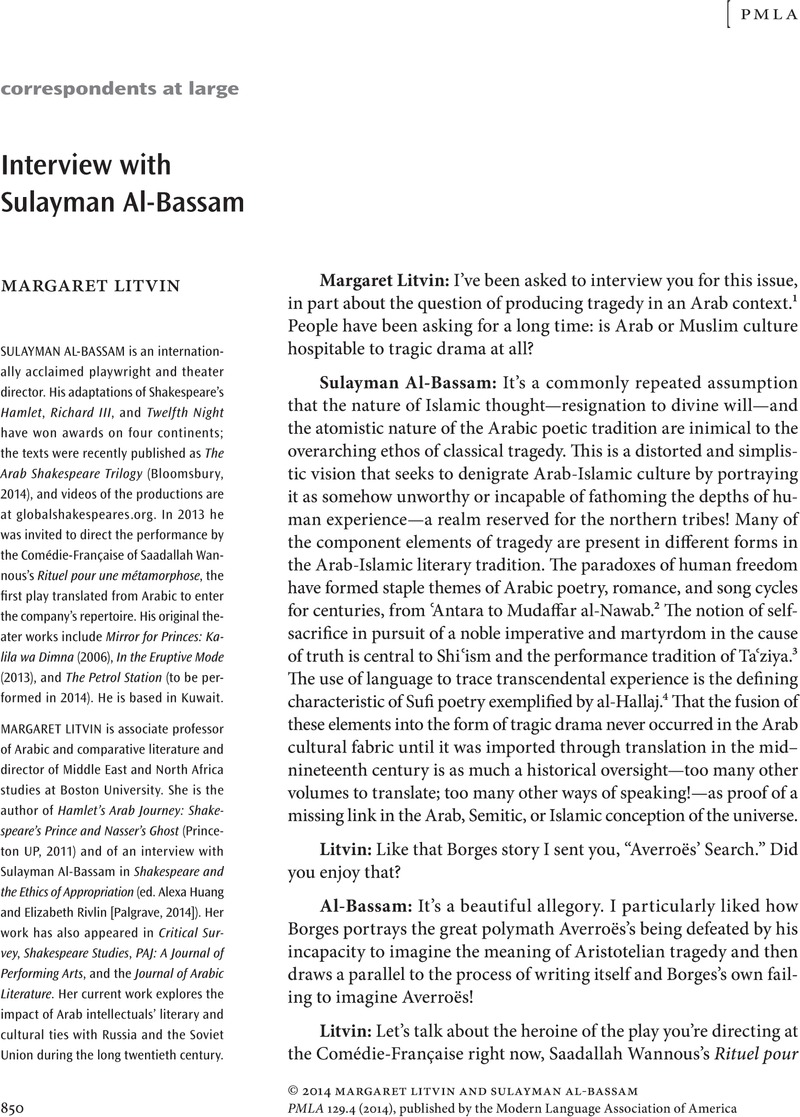No CrossRef data available.
Article contents
Interview with Sulayman Al-Bassam
Published online by Cambridge University Press: 23 October 2020
Abstract
An abstract is not available for this content so a preview has been provided. Please use the Get access link above for information on how to access this content.

- Type
- Correspondents at Large
- Information
- Copyright
- Copyright © Modern Language Association of America, 2014
References
Works Cited
Bohlen, Celestine. “Arab Voices on a Venerable Paris Stage.” The New York Times. New York Times, 5 July 2013. Web. 19 June 2014.Google Scholar
Cappelle, Laura. “Rituel pour une métamorphose, Comédie-Française, Paris—Review.” Financial Times. Financial Times, 22 May 2013. Web. 19 June 2014.Google Scholar
Litvin, Margaret. “Explosive Signifiers: Sulayman Al-Bassam's Post-9/11 Odyssey.” Shakespeare after 9/11: How a Social Trauma Reshapes Interpretation. Ed. Biberman, Matthew and Lupton, Julia Reinhard. Lewiston: Mellen, 2011. 103–35. Print.Google Scholar
Litvin, Margaret. “From Tahrir to ‘Tahrir’: Some Theatrical Impulses toward the Egyptian Uprising”. Theatre Research International 38.2 (2013): 116–23. Print.Google Scholar
Litvin, Margaret. “Review of The Speaker's Progress (directed by Sulayman Al-Bassam), Paramount Theatre, Boston, USA, October 12-16, 2011”. Shakespeare 9.3 (2013): 350–52. Web. 19 June 2014.Google Scholar
Myers, Robert, and Saab, Nada. “Sufism and Shakespeare: The Poetics of Personal and Political Transformation in Sa'dallah Wannus's Tuqus al-Isharat wa-l-Tahawwulat”. Theatre Research International 38.2 (2013): 124–36. Print.Google Scholar
Salino, Brigitte. “Un drame syrien entre à la Comédie-Française.” Le monde. Le Monde.fr, 4 May 2013. Web. 19 June 2014.Google Scholar
Wannous, Sa'dallah. Rituals of Signs and Transformations. Trans. Myers, Robert and Saab, Nada. Four Plays from Syria. Ed. Carlson, Marvin and Mahfouz, Safi. New York: Martin E. Segal Center, 2014. Print.Google Scholar


